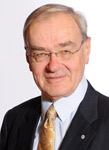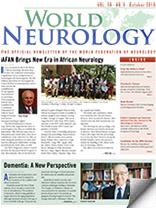By Vladimir Hachinski, MD

Vladimir Hachinski
As dementia rises in prevalence, new approaches must be adopted in the treatment of the condition and efforts to prevent it.
Dementia means the loss of brain capacity severe enough to result in the loss of self-sufficiency. The incidence of dementia, which is rising globally, is largely driven by the aging population. Although dementia increases with age, it is not inevitable with age. Dementia represents the end stage of several processes, for which some are treatable and preventable.
Brain blood vessels (vascular) and Alzheimer’s disease represent the two most common pathologies leading to dementia. The changes of Alzheimer’s disease are characterized by the deposition of amyloid protein plaques and of tau protein aggregation forming tangles in neurons. The changes that lead to Alzheimer’s disease begin about 20 years before any symptoms appear. Many elderly individuals die with plaques and tangles without having had any trouble in life as a result. Similarly, most vascular disease is insidious. For each stroke that affects the body, five affect the mind, usually with the person being unaware of them.
While Alzheimer’s and cerebrovascular pathology occur commonly with age, mostly without symptoms, the combination doubles the chances that the dormant pathologies will result in dementia. Although cerebrovascular disease is treatable and preventable, scant attention has been paid to this component, present in 80 percent of Alzheimer’s patients.
Instead, the declared intention is to find a cure or disease-modifying drug by 2025. The idea of giving one drug to an amalgam of pathologies broadly defined as Alzheimer’s disease may prove as disappointing as the litany of failed trials that took place in the late 1990s and early 2000s aimed at stopping the damage that follows a stroke with a single drug. Since dementia has multiple causes, one must try multiple therapies, including addressing the one component that can be treated and prevented: the vascular one.
Dementia is not a threshold but a continuum. The process begins decades before any symptoms appear, a phase termed the “brain-at-risk stage.” The earlier the risk factors are recognized and treated, the better the chance of success.
Knowledge accrues in pieces, but is understood in patterns. Specialization fosters fragmentation and fiefdoms. It turns out that all major brain diseases result from different combinations of half a dozen mechanisms. By integrating this knowledge, researchers may discover that drugs developed for one purpose in one field may have application in another. If we only knew what we already know.
The Need for Multiple Therapies
The diagnosis of Alzheimer’s disease is notoriously imprecise, mainly because most patients harbor multiple pathologies. Even if a drug were 100 percent effective in blocking amyloid deposition, its effect might be obscured or overwhelmed by concomitant pathologies, for example brain vascular disease and its interactions, such as inflammation, if not treated at the same time. This calls for multiple therapies and new methodologies, such as platform trials to evaluate multiple therapies simultaneously. The lack of precision in diagnostic categories can be overcome by identifying specific contributing mechanisms leading to dementia and treating them. It is now possible to image vascular disease, amyloid and tau protein deposition and inflammation in the brain. Each of these mechanisms can be treated individually or in combination.
The evaluation of drugs can be accelerated by developing protocols in close reciprocal interactions with experimental work in a few advanced centers. These would continue with extensive protocols and thorough evaluation of patients. Once experience has been gained, a protocol could be simplified so that large numbers of patients could be enrolled. At predetermined intervals, statistically valid samples of patients following the simplified protocol would be studied by those following the extensive study protocol to make sure that they were similar.
In the era of big data and electronic records, it may be possible to do more sophisticated post-marketing surveillance and gain real-world knowledge of the effectiveness of different treatments.
Unhealthy diets, physical inactivity and tobacco and alcohol addiction represent identifiable risks for stroke and dementia and other non-communicable diseases targeted by the United Nations resolution of September 2011. In order to succeed, a three-step approach is required:
- Information
- Motivation
- Enablement
Good information is essential, but by itself is no more effective than New Year’s resolutions. Motivation matters but is seldom addressed. Healthy lifestyles require a healthy environment, and policymakers have a particular role in creating it. They also have a leadership role in introducing legislation to curb tobacco and alcohol use and limit the consumption of unhealthy foods. They also have a major role in ensuring that our air is breathable. Air pollution can harm the lungs, damage the heart and afflict the brain. What happens in Beijing matters at Schloss Elmau: We share the same biosphere. Policymakers can follow the lead of Finland in considering health in all policies. Public health could be enhanced considerably through the leadership of non-governmental organizations. Additionally, policymakers can get help from international brain organizations, which can provide expertise and patient support groups, and can help to mobilize the public toward healthier lifestyles and risk-factor control, which may prevent or postpone major chronic diseases, including dementia.
Conclusions
Dementia results most often from a combination of Alzheimer’s and cerebrovascular pathologies and their interaction. Cerebrovascular disease is both treatable and preventable.
The diagnosis of dementia is imprecise, but it is now possible to identify and target the different mechanisms leading to brain deterioration. This will require multiple interventions and new clinical trial methodologies.
Dealing with the challenges of dementia will require not only new resources, but new thinking and different approaches as well.
Vladimir Hachinski, MD, is the Distinguished University Professor at Canada’s University of Western Ontario. With John W. Norris, he founded the world’s first successful acute stroke unit. With David Cechetto, he discovered the role of the brain’s insula in sudden death, and, joined by Shawn Whitehead, they established a treatable link between Alzheimer’s disease and stroke. He has authored, co-authored or co-edited 17 books and more than 600 widely cited publications. He was president of the World Federation of Neurology from 2010 to 2013 and the founding and past chair of the World Brain Alliance.
Article originally published in G7 Germany: The Schloss Elmau Summit. www.g7g20.com.
